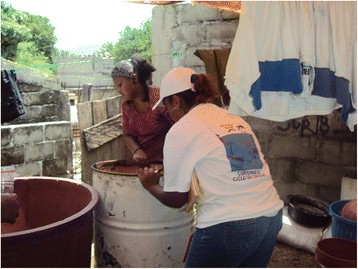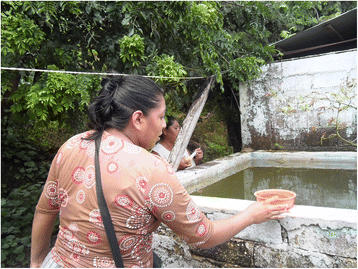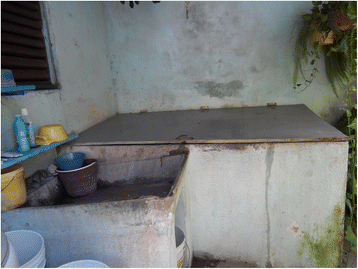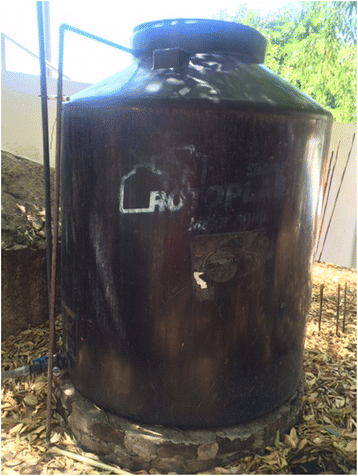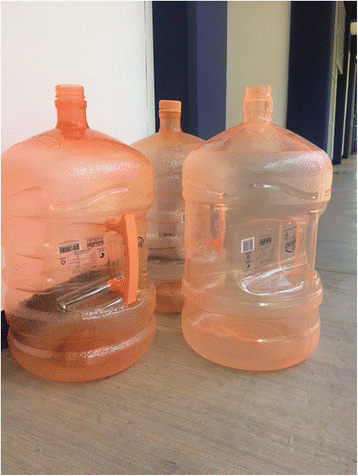Aedes aegypti breeding ecology in Guerrero: cross-sectional study of mosquito breeding sites from the baseline for the Camino Verde trial in Mexico
- PMID: 28699559
- PMCID: PMC5506586
- DOI: 10.1186/s12889-017-4293-9
Aedes aegypti breeding ecology in Guerrero: cross-sectional study of mosquito breeding sites from the baseline for the Camino Verde trial in Mexico
Abstract
Background: Understanding the breeding patterns of Aedes aegypti in households and the factors associated with infestation are important for implementing vector control. The baseline survey of a cluster randomised controlled trial of community mobilisation for dengue prevention in Mexico and Nicaragua collected information about the containers that are the main breeding sites, identified possible actions to reduce breeding, and examined factors associated with household infestation. This paper describes findings from the Mexican arm of the baseline survey.
Methods: In 2010 field teams conducted household surveys and entomological inspections in 11,995 households from 90 representative communities in the three coastal regions of Guerrero State, Mexico. We characterized Ae. aegypti breeding sites and examined the effect of two preventive measures: temephos application in water containers, and keeping the containers covered. We examined associations with household infestation, using bivariate and multivariate analysis adjusted for clustering effects.
Results: We conducted entomological inspections in 11,995 households. Among 45,353 water containers examined, 6.5% (2958/45,353) were positive for larvae and/or pupae. Concrete tanks (pilas) and barrels (tambos) together accounted for 74% of pupal productivity. Both covering water containers and inserting temephos were independently associated with a lower risk of presence of larvae or pupae, with the effect of covering (OR 0.22; 95% CIca 0.15-0.27) stronger than that of temephos (OR 0.66; 95% CIca 0.53-0.84). Having more than four water containers was associated with household infestation in both rural areas (OR 1.42; 95% CIca 1.17-1.72) and urban areas (1.81; 1.47-2.25), as was low education of the household head (rural: 1.27; 1.11-1.46, and urban: 1.39; 1.17-1.66). Additional factors in rural areas were: household head without paid work (1.31; 1.08-1.59); being in the Acapulco region (1.91; 1.06-3.44); and using anti-mosquito products (1.27; 1.09-1.47). In urban areas only, presence of temephos was associated with a lower risk of household infestation (0.44; 0.32-0.60).
Conclusion: Concrete tanks and barrels accounted for the majority of pupal productivity. Covering water containers could be an effective means of Ae. aegypti vector control, with a bigger effect than using temephos. These findings were useful in planning and implementing the Camino Verde trial intervention in Mexico.
Keywords: Aedes aegypti; Dengue; Pupal productivity; Temephos.
Figures
Similar articles
-
"Where we put little fish in the water there are no mosquitoes:" a cross-sectional study on biological control of the Aedes aegypti vector in 90 coastal-region communities of Guerrero, Mexico.BMC Public Health. 2017 May 30;17(Suppl 1):433. doi: 10.1186/s12889-017-4302-z. BMC Public Health. 2017. PMID: 28699557 Free PMC article. Clinical Trial.
-
Coverage and beliefs about temephos application for control of dengue vectors and impact of a community-based prevention intervention: secondary analysis from the Camino Verde trial in Mexico.BMC Public Health. 2017 May 30;17(Suppl 1):426. doi: 10.1186/s12889-017-4297-5. BMC Public Health. 2017. PMID: 28699554 Free PMC article. Clinical Trial.
-
Beyond efficacy in water containers: Temephos and household entomological indices in six studies between 2005 and 2013 in Managua, Nicaragua.BMC Public Health. 2017 May 30;17(Suppl 1):434. doi: 10.1186/s12889-017-4296-6. BMC Public Health. 2017. PMID: 28699558 Free PMC article. Clinical Trial.
-
Systematic Review of Impacts of Educational Interventions to Control Breeding Sites of Aedes aegypti and Aedes albopictus Mosquitoes.Am J Trop Med Hyg. 2024 Apr 2;110(5):979-988. doi: 10.4269/ajtmh.23-0427. Print 2024 May 1. Am J Trop Med Hyg. 2024. PMID: 38579697 Free PMC article.
-
[Dengue prevention and control: a review of studies on knowledge, beliefs, and practices].Cad Saude Publica. 2004 Nov-Dec;20(6):1447-57. doi: 10.1590/s0102-311x2004000600002. Epub 2004 Dec 8. Cad Saude Publica. 2004. PMID: 15608846 Review. Portuguese.
Cited by
-
Dengue occurrence relations and serology: cross-sectional analysis of results from the Guerrero State, Mexico, baseline for a cluster-randomised controlled trial of community mobilisation for dengue prevention.BMC Public Health. 2017 May 30;17(Suppl 1):435. doi: 10.1186/s12889-017-4291-y. BMC Public Health. 2017. PMID: 28699560 Free PMC article. Clinical Trial.
-
Automatic mapping of high-risk urban areas for Aedes aegypti infestation based on building facade image analysis.PLoS Negl Trop Dis. 2024 Jun 3;18(6):e0011811. doi: 10.1371/journal.pntd.0011811. eCollection 2024 Jun. PLoS Negl Trop Dis. 2024. PMID: 38829905 Free PMC article.
-
Higher abundance of the vector Aedes aegypti in rural areas than in urban areas in Managua, Nicaragua.Res Sq [Preprint]. 2025 Mar 12:rs.3.rs-6059011. doi: 10.21203/rs.3.rs-6059011/v1. Res Sq. 2025. PMID: 40162232 Free PMC article. Preprint.
-
The influence of gender and temephos exposure on community participation in dengue prevention: a compartmental mathematical model.BMC Infect Dis. 2024 May 2;24(1):463. doi: 10.1186/s12879-024-09341-w. BMC Infect Dis. 2024. PMID: 38698345 Free PMC article. Clinical Trial.
-
Randomised controlled trials and changing public health practice.BMC Public Health. 2017 May 30;17(Suppl 1):409. doi: 10.1186/s12889-017-4287-7. BMC Public Health. 2017. PMID: 28699541 Free PMC article.
References
-
- Organización Panamericana de la Salud/Organización Mundial de la Salud . Dengue guías para el diagnóstico, tratamiento, prevención y control. La Paz: OPS/OMS; 2010.
-
- Orgaización Panamericana de la Salud Plan Continental de ampliación e intensificación del combate a Aedes aegypti. Rev Panam Salud Publica/Pan Am J Public Health. 1998;3(2):124–130.
-
- Gubler DJ. Aedes aegypti and Aedes aegypti-borne disease control in the 1990s: top down or bottom up. Am J Trop Med Hyg. 1989;40:571–8. - PubMed
Publication types
MeSH terms
Substances
LinkOut - more resources
Full Text Sources
Other Literature Sources
Medical

